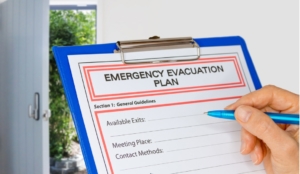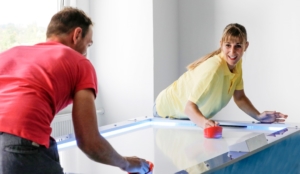
If a fire breaks out in your home, every second counts. Most people understand the importance of smoke alarms and how they can be lifesaving in the case of an emergency, but equally important is having a fire plan for your family so everyone knows what to do if a fire does break out.
The National Fire Protection Association offers guidelines that can help people put together a plan. Here are some things you should do:
First, gather your family and talk about how the most important thing to do if a fire breaks out is to leave the house immediately. Don’t run into a room to grab photos or a beloved heirloom. Don’t stop to find your sneakers. Just leave the house. Fire spreads quickly and even if flames haven’t gotten to the room where you want to save something, you could find yourself trapped.
A great thing to do is go through your home and look at all the possible exits and escape routes so you know what to do if you do wind up being trapped. Those with children should consider drawing a floor plan of your home, marking the ways out of each room.
Walk through your plan and check to make sure the routes are clear and doors and windows can be opened easily. You may think you have an easy out of a window, but if it’s stuck and won’t open easily, it could lead to disaster.
If there are infants, older adults or family members with mobility limitations in the house, make sure that someone is assigned to assist them in in the event of an emergency. And have a backup in case that person isn’t home if a fire were to break out.
For those with rooms on an upper level, having escape ladders is a good way to ensure that there will be a way out, even if the fire has permeated the floor. Practice setting up the ladder from a first-floor window to make sure you can do it correctly and quickly. And store it in a place that’s easy to get to (like under the bed) so you can find it right away if needed.
Choose an outside meeting place a safe distance in front of your home where everyone can meet after they’ve left the house so you know everyone is safe. And never go back in the home. Your mind might start thinking about that valuable vase or irreplaceable collectible, but your life is worth more than anything ever could be. Once out of the home, remain out and let the fire department come and do their job.
It’s a good idea to run a fire drill at least once a year so you can make sure everyone knows what to do and there will be less uncertainty if a future fire event does happen.

Five Easy Ways to Brighten Your Day
Is your daily routine bogging you down? Are you going through a hard time? Did you wake up feeling a bit blah? Of course, it’s normal to feel down every once in a while, but it’s also possible to find a way to brighten your day, even if you have to hardwire it. Here are five easy ways to help improve your mood:
Smile. The saying “fake it ’til you make it” has been proven to work when it comes to smiling. While it can feel painful to put on a faux grin, a few minutes of smiling a day really can boost your mood. Struggling to pull it off? Set aside 10 minutes and watch your favorite comedian or cute puppy videos to spark a genuine laugh or two.
Dance. Take a short dance break and blast your favorite songs. Not only will you get your blood moving, but you’ll also boost your endorphins. The more upbeat the tune, the better!
Snuggle. Human touch does wonders for your mood, and numerous studies have shown that cuddling can make us feel better. Don’t have a snuggle buddy? A four-legged friend works, too.
Get outside. A lack of vitamin D can be a huge mood drain. Take 10 minutes to go for a short walk during daylight hours and help lift your spirits. Grab a friend and walk to the local coffee or smoothie shop for an even bigger boost.
Play. All work and no play makes everyone dull. We all have different play methods-video games, golf, painting, bicycling. Find whatever feels like fun “you” time and spend a small amount of time daily—or at least weekly—working it into your schedule to feel fulfilled.
These are just five ways to try and find a smile. Whether you’re feeling a bit down or just looking for new tricks to add more joy, exploring healthy ways to brighten your day can do wonders to help lift your spirits.
Make an Investment the Whole Family Can Play With
Air hockey is a game that is easy to understand and caters to everyone in the family, from ages 5 to 99. Kids love the action in the game and parents love a game that gets the kids away from video games. It also helps that the kids burn a little energy playing air hockey.
That’s why air hockey is becoming popular again and many homes are investing in tables.
For a few years, the air hockey table trend was leaning toward furniture style tables, but in 2019, the trend has been leaning toward the commercial, arcade-style tables. These aren’t too expensive, and they are easy to bring into the home.
While the basic game of air hockey hasn’t changed much since its inception in the ’70s, today’s manufacturers have dressed up the game to appeal to the kids and the families that buy them. That means automatic scoring with music and crowd noise has become the norm, and colorful playfields with cool graphics have added lots of appeal.
Air flow on an air hockey table is measured in cubic feet per minute (CFM), and today’s tables operate more as an air tunnel effect, meaning rather than blowing the air directly up from the bottom, tables are now blowing the air from the side into a chamber and then circulating the air so it’s not pushing straight back. That angles the air and creates a bit of a vortex, creating consistent pressure, which allows the table to breathe more evenly.
Other innovations in air hockey tables of late include enhancements in lighting effects, such as lights flashing on and off when goals are scored and LED pucks and pushers that light up. Sound effects have been improved as well, with the sounds of crowds cheering and mimicking of the announcer being added to many tables. Then there’s game music paired together with cascading light effects bringing additional excitement to the game.
Larger, heavier pucks and ergonomic pushers are both staples with air hockey today. The former keeps the puck from flying off the table so much, while the latter prevents or reduces the risk of hand and wrist strain while allowing harder hits to the puck.
Whether you’re moving into a new home or just want to add some excitement to your house, adding an air hockey table can bring in loads of fun.
Five Ideas for the Extra Room in Your House
The Art of Hanging Artwork
Hanging artwork is an art—literally. Too high, and the room feels off balance. Too low, and, well…you get the idea.
One of the most common mistakes homeowners make, according to Apartment Therapy’s Eleanor Büsing, is hanging pieces at the wrong level. To help you spruce up your place with properly placed artwork, Büsing offers the following tips:
Establish eye level. Eye level in most houses is approximately 57 to 60 inches from the floor. All artwork, regardless of orientation, should be hung so that the center (not the top or bottom) of the piece is at eye level.
Coordinate with orientation. The orientation of the piece—landscape (horizontal) or portrait (vertical)—should coordinate with the wall space it’ll hang on. The area above a sofa, for example, is horizontal, so the artwork should be oriented landscape.
Portraits can be hung in horizontal spaces, however—the trick is to hang them side by side so that they appear as one horizontal piece. The opposite also applies: Landscapes can be hung in vertical spaces, so long as they’re stacked one on top of the other.
Align varying sizes. A complementary duo or trio of artwork in different sizes should be hung in alignment with the pieces’ center points—this means that the tops of some pieces will be higher than others. Avoid aligning them by their tops or bottoms.
Stay uniform. Multiple pieces of artwork hung improperly can make a room seem cluttered and cramped. Make a gallery uniform by arranging the pieces in a precise grid format with matching frames, or by hanging one “anchor piece” at eye level and hanging other pieces outward from there.
Whichever of these tips you use, consistency is key. Keep eye level in mind as you hang artwork throughout your home to maintain a sense of flow
The Importance of a Fire Plan
If a fire breaks out in your home, every second counts. Most people understand the importance of smoke alarms and how they can be lifesaving in the case of an emergency, but equally important is having a fire plan for your family so everyone knows what to do if a fire does break out.
The National Fire Protection Association offers guidelines that can help people put together a plan. Here are some things you should do:
First, gather your family and talk about how the most important thing to do if a fire breaks out is to leave the house immediately. Don’t run into a room to grab photos or a beloved heirloom. Don’t stop to find your sneakers. Just leave the house. Fire spreads quickly and even if flames haven’t gotten to the room where you want to save something, you could find yourself trapped.
A great thing to do is go through your home and look at all the possible exits and escape routes so you know what to do if you do wind up being trapped. Those with children should consider drawing a floor plan of your home, marking the ways out of each room.
Walk through your plan and check to make sure the routes are clear and doors and windows can be opened easily. You may think you have an easy out of a window, but if it’s stuck and won’t open easily, it could lead to disaster.
If there are infants, older adults or family members with mobility limitations in the house, make sure that someone is assigned to assist them in in the event of an emergency. And have a backup in case that person isn’t home if a fire were to break out.
For those with rooms on an upper level, having escape ladders is a good way to ensure that there will be a way out, even if the fire has permeated the floor. Practice setting up the ladder from a first-floor window to make sure you can do it correctly and quickly. And store it in a place that’s easy to get to (like under the bed) so you can find it right away if needed.
Choose an outside meeting place a safe distance in front of your home where everyone can meet after they’ve left the house so you know everyone is safe. And never go back in the home. Your mind might start thinking about that valuable vase or irreplaceable collectible, but your life is worth more than anything ever could be. Once out of the home, remain out and let the fire department come and do their job.
It’s a good idea to run a fire drill at least once a year so you can make sure everyone knows what to do and there will be less uncertainty if a future fire event does happen.
Five Easy Organizational Tips
Do you feel like you’re constantly battling clutter around the house? You’re not alone, and nothing can feel more frustrating than not being able to locate something when you need it, or wading through piles of items to get there. Below are five, easy organizational tips that can offer major upgrades:
Tension Rod for Pot Lids
If you store your pots and pans in a drawer, install a tension rod along the inside and slip your pot lids behind it. No more rattling pots or hard-to-find tops!
Gallon Bags for Drawers
Organize your underwear or t-shirt drawer by separating your items and storing them in gallon-sized plastic bags. You’ll never lose 10 minutes hunting for that pair of socks again.
CD Holders for Tupperware
Remember those old CD racks? Repurpose them in your Tupperware cabinet by using them to keep your lids separate, sorted and easy to grab.
Repurposed Wine Rack
Gifted a large wine rack that rarely feels full? Use it in a hallway or closet to store shoes, scarves and other items that need to be tucked away.
Muffin Tin Magic
Have a junk drawer that never stays organized? Slip a muffin tin inside to separate your odds and ends.
Healthy Ways to Manage Stress
We all have stress in our lives. Busy days at work, problems at home, traffic jams and money trouble are prime examples of stressful situations. However, chronic stress can lead to serious health issues, such as heart disease, high blood pressure and depression, so preventing and managing stress is essential to living happier and healthier.
Here are some tips from the U.S. Department of Health and Human Services to help you deal with stress:
Prepare yourself. Prepare ahead of time for stressful events like a job interview or a hard conversation with a loved one. Stay positive, picture what the room will look like and what you’ll say, and have a backup plan.
Plan your time. Feeling in control of your situation could lower stress. Think ahead about how you’re going to use your time. Write a to-do list and figure out what’s most important-then do that thing first. Be realistic about how long each task will take.
Relax with deep breathing or meditation. These are two effective ways to relax your muscles and clear your mind.
Relax your muscles. Stress causes tension in your muscles. Try stretching or taking a hot shower to help you relax.
Get active. Regular physical activity can help prevent and manage stress. It can also help relax your muscles and improve your mood. Aim for 2.5 hours a week of physical activity. Try riding a bike, taking a walk or lifting weights. Be sure to exercise for at least 10 minutes at a time.
Eat healthy. Give your body plenty of energy by eating healthy, including vegetables, fruits and lean sources of protein.
Talk to friends and family. Tell your friends and family if you’re feeling stressed. They may be able to help.
Get professional help if you need it. Stress is a normal part of life. But if your stress doesn’t go away or keeps getting worse, you may need expert help. A mental health professional, such as a psychiatrist or social worker, can help treat stress-related conditions. Lots of people need help dealing with stress-it’s nothing to be ashamed of.
Five Design Features for a Luxurious Year-Round Outdoor Space
Six Tips to Design a Contemporary Kitchen